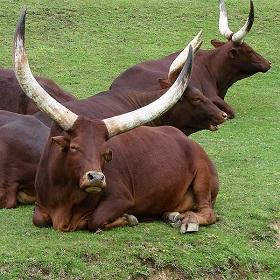Using AI to control energy for indoor agriculture
30 September 2024
Published online 10 April 2014

© Vassil
The team of 16 international researchers led by Jared Decker, assistant professor of Animal Science at the Missouri University College of Agriculture, Food and Natural Resources, genotyped 1,543 cattle samples from 134 cattle breeds from around the world to determine how they are related.
African cattle genomes were very similar to those of cattle first domesticated in the Middle East about 10,000 years ago, the researchers discovered, concluding that those cattle were either brought to Africa when farmers migrated south, or traded, before interbreeding with African wild cattle, aurochs.
"We can't determine whether the movement of cattle into Africa was due to population movements or trade," says Decker. "What we can infer is that the owners of these domesticated cattle from the Fertile Crescent either intentionally or unintentionally crossed their cattle with wild African aurochs."
African cattle have some unique qualities, such as resistance to trypanosomiasis, or sleeping sickness, and the researchers considered whether this resistance evolved in domesticated cattle or in the wild African aurochs with which they interbred.
The results also showed that native cattle in Indonesia were mixed with imports from India, imports from Europe and Africa were mixed with local breeds in Italy and Spain, and European and Asian cattle imports were mixed with native cattle in Korea and Japan.
"We can also see other patterns about how cattle were moved," says the researcher. "Cattle in East Asia have similar ancestry to cattle in the Mediterranean, so we can infer that cattle were brought along the Silk Road to East Asia. We can deduce that cattle were traded or moved from Southern Europe (Spain and Italy) to Northern Africa and cattle were likewise taken from Northern African into Southern Europe."
According to Jerry Taylor, from the Division of Animal Sciences at MU who co-authored the study, Taurine cattle from the Fertile Crescent were probably traded into African herds in northeastern Africa and then multiplied, with infusion from African aurochs, before being traded throughout the continent.
While the genomic dataset collated by the researchers represents the largest population sampling of any mammalian species and allows for an extremely detailed description of the population structure of domesticated cattle worldwide, Taylor points out that "there are about 800 recognized breeds of cattle in the world and so far we have only completed 16%."
Understanding the genetic history of cattle breeds is fundamental when looking at solutions for agricultural issues and can help modern cattle breeders. "By identifying specific variants in genes that are found only within phylogenetically closely related breeds, we can begin to postulate their function and potential agricultural value and importance," says Taylor.
Ahmed El-Beltagi, who works in animal biotechnology and molecular breeding at the Agricultural Research Center in Cairo, suggests this could help take agricultural decisions. "The West African Taurine 'N'Dama' breed is resistant to heat and trypanotolerant, allowing the cattle to be kept in tsetse fly infested areas, which reflects the signature of natural selection, while the high milk productivity of the European Jersey and meat production of the Beef Shorthorn are the products of manmade selection and breeding," he explains.
In the future, disease resistance, adaptation to nutritionally limited environments and climatic stresses will become increasingly important, and choosing the right cattle breed for a specific environment could increase meat and dairy production.
doi:10.1038/nmiddleeast.2014.89
Stay connected: